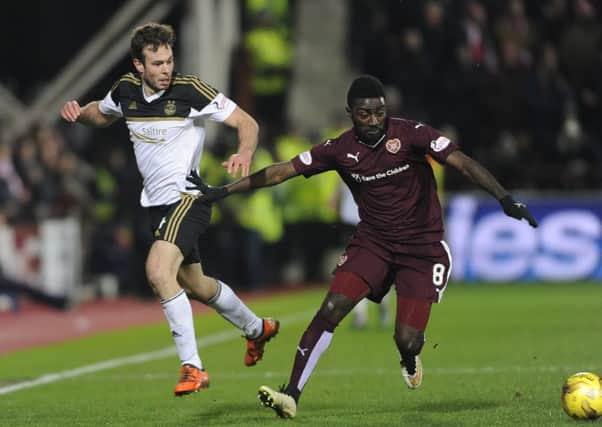Five things we learned from Hearts 1 - 0 Aberdeen
This article contains affiliate links. We may earn a small commission on items purchased through this article, but that does not affect our editorial judgement.


Hearts’ pressing gave them the impetus
The home side won the game behind a dominant first half performance. During the period they swarmed around the park, never giving the visitors a second to consider their options, and got the ball forward quickly into dangerous areas.
Hearts wanted to do something similar the last time the teams met at Tynecastle, only there were two crucial differences here. The first is that their high pressing was much more effective. Aberdeen’s back-line were often forced into knocking aimless balls forward as they felt the heat from a Hearts attacker, meaning the play just kept coming back into the Aberdeen half. The second is that the Hearts back-line sagged a little more when compared with the first meeting, never allowing Aberdeen to get in behind on the counter, something they did to devastating effect in the 3-1 victory back in September.
Advertisement
Hide AdAdvertisement
Hide AdThis tailed off a little in the second period, though it was always going to. It’s just not humanly possible to keep up such intensity for 90 minutes against a good side. Aside from a couple of spells, however, Hearts still retained a decent amount of play in the second period and can justifiably feel the victory was deserved.
Niall McGinn and Johnny Hayes were kept quiet
It’s no coincidence that Aberdeen’s strongest periods in the match - the first 15 minutes of the second half and the last five minutes of the game - came with McGinn and Hayes having their busiest spells.
Aberdeen rely heavily on these two players to have an impact on games and really struggle when they each have off days, as was the case at Tynecastle.
Kenny McLean has greatly improved since his arrival from St Mirren, but he’s not yet reached the point where he can be considered a potential talisman. And Adam Rooney, undoubtedly a great goal threat, needs service to score and can’t create much on his own.
It’s also no coincidence the striker was fairly quiet against Hearts with just a couple of half chances to his name. He’s netted 14 times this season but six have been penalties, and of the remaining eight McGinn or Hayes has assisted on six of them.
Osman Sow and Arnaud Djoum were in top form
When Djoum and Sow are on form there’s very little that can be done to stop Hearts.
Sow completely dominated Mark Reynolds in the first half and the striker’s only regret from the match will be his failure to score. His speed and ability to out-muscle opponents gives defenders a battle on two fronts. There are few strikers in the top flight of Scotland capable of both knocking a defender on his backside and leaving him for dust in a foot race.
Djoum has been a little quiet since extending his deal at Hearts, but he rose to the occasion in this match. Hearts need him to be the team’s threat from central midfield and he showed more enthusiasm for joining the attack on this occasion. He’s also an intelligent passer of the ball and someone who shows great awareness in traffic. Both attributes helped him stand-out in a frantic midfield area.
Hearts could finally have settled on a strongest XI
Advertisement
Hide AdAdvertisement
Hide AdRobbie Neilson has ‘tinkerman’ tendencies so there’s every chance this team will be adapted in different ways throughout the upcoming weeks to counter-act the strengths of opposition sides. However, it’s safe to say some of the alterations to the starting XI throughout the season are a result of the Hearts boss searching for his best side, with injuries also playing a role, rather than making tweaks here and there for the sake of it.
It’s a team that has great balance throughout it. Playing with a natural centre midfielder on the right in Prince Buaben means the duo in the centre, Djoum and Miguel Pallardo, are not swamped by the opposition, while it also allows Callum Paterson greater room to attack from deep. It’s actually the opposite on the other flank, with Sam Nicholson attacking more down the wing and Igor Rossi preferring a more cautious approach, but it still retains the same balance.
Up front, Sow and Gavin Reilly make a dynamic partnership, and while there’s a lack of aerial threat from the pair the rest of the team, overall, make up for this at set-pieces. Every member of the back four is over six foot tall and capable of scoring with their head.
The only concern is the Alim Ozturk / Blazej Augustyn centre back pairing. Both defenders are proactive in their approach, and this can lead to rushes of blood to the head, with Rossi a calmer influence in the centre. However, Ozturk was more restrained in his performance against Aberdeen and if he can continue to adapt in this manner then his side should be fine.
Aberdeen v Hearts is turning into a real rivalry
It’s now clear to see there’s a mutual dislike between these two sides with a couple of flash points and a post-match slagging session.
Aberdeen feel Hearts are guilty of rough tactics, while the men in maroon don’t think their football playing capabilities are given the respect they deserve.
Then there was the incident late on where the Dons decided against returning possession after it had been kicked out of play by Neil Alexander with Ozturk down on the turf. Hearts said it was unsporting; Aberdeen felt Ozturk’s injury was an act of gamesmanship. Regardless of which side you fall on, it’s certainly added spice to the race for second, which can only be a good thing for Scottish football.